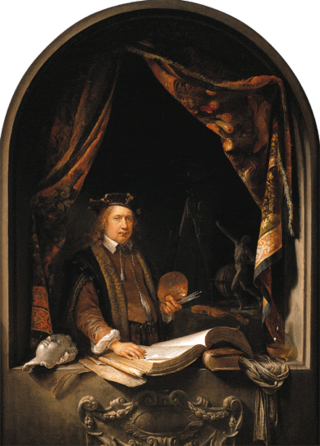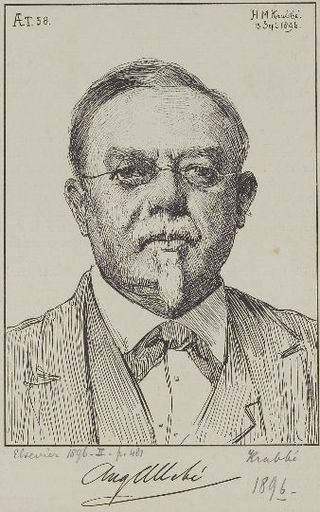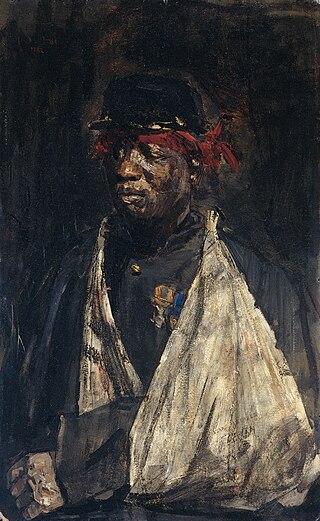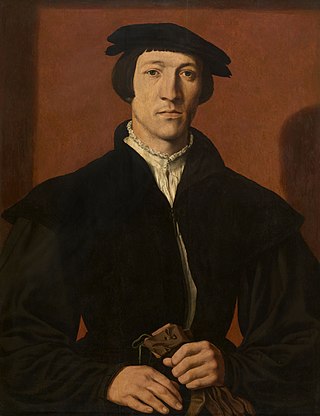
The Rijksmuseum is the national museum of the Netherlands dedicated to Dutch arts and history and is located in Amsterdam. The museum is located at the Museum Square in the borough of Amsterdam South, close to the Van Gogh Museum, the Stedelijk Museum Amsterdam, and the Concertgebouw.

Matthias Grünewald was a German Renaissance painter of religious works who ignored Renaissance classicism to continue the style of late medieval Central European art into the 16th century. His first name is also given as Mathis and his surname as Gothart or Neithardt.
Sinterklaas or Sint-Nicolaas is a legendary figure based on Saint Nicholas, patron saint of children. Other Dutch names for the figure include De Sint, De Goede Sint and De Goedheiligman. Many descendants and cognates of "Sinterklaas" or "Saint Nicholas" in other languages are also used in the Low Countries, nearby regions, and former Dutch colonies.

Gerrit Dou, also known as GerardDouw or Dow, was a Dutch Golden Age painter, whose small, highly polished paintings are typical of the Leiden fijnschilders. He specialised in genre scenes and is noted for his trompe-l'œil "niche" paintings and candlelit night-scenes with strong chiaroscuro. He was a student of Rembrandt.

Nicolaes Maes was a Dutch painter known for his genre scenes, portraits, religious compositions and the occasional still life. A pupil of Rembrandt in Amsterdam, he returned to work in his native city of Dordrecht for 20 years. In the latter part of his career he returned to Amsterdam where he became the leading portrait painter of his time. Maes contributed to the development of genre painting in the Netherlands and was the most prominent portrait painter working in Amsterdam in the final three decades of the 17th century.

Jan Mostaert was a Dutch Renaissance painter who is known mainly for his religious subjects and portraits. One of his most famous creations was the Landscape with an Episode from the Conquest of America.

Joos van Cleve was a leading painter active in Antwerp from his arrival there around 1511 until his death in 1540 or 1541. Within Dutch and Flemish Renaissance painting, he combines the traditional techniques of Early Netherlandish painting with influences of more contemporary Renaissance painting styles.

Frans Francken the Younger was a Flemish painter and the best-known and most prolific member of the large Francken family of artists. Francken painted a range of subjects, producing large altarpieces for churches as well as smaller historical, mythological and allegorical scenes. His depictions of collectors' cabinets established a popular new genre of art in the era. Francken often collaborated with other artists, adding figures and narrative elements to scenes created by specialists in landscape, architectural scenes, and floral still life painting..

Gillis Mostaert the Elder was a Flemish Renaissance painter and draughtsman active in Antwerp in the second half of the 16th century. He was a versatile artist who worked in various genres including landscape, genre and history painting. Gillis Mostaert was known in particular for his winter landscapes and his scenes with fires and nocturnal scenes and his works in this genre were among the most sought after pieces of his time. The artist operated a large workshop in Antwerp, which supplied works to prominent patrons. He was a regular collaborator with leading Antwerp artists of his time.

Zwarte Piet, also known in English by the translated name Black Pete, is the companion of Saint Nicholas in the folklore of the Low Countries. The earliest known illustration of the character comes from an 1850 book by Amsterdam schoolteacher Jan Schenkman in which he was depicted as a black Moor from Spain.

August Allebé was an artist and teacher from the Northern Netherlands. His early paintings were in a romantic style, but in his later work he was an exponent of realism and impressionism. He was a major initiator and promoter of Amsterdam Impressionism, the artist's association St. Lucas, and the movement of the Amsterdamse Joffers. Amsterdam Impressionism – sometimes referred to by art historians as the School of Allebé – was the counterflow to the very strong Hague School in the movement of Dutch Impressionism. As a professor at the Royal Academy of Amsterdam he fostered a cosmopolitan attitude toward art and the promotion and motivation of his students, and provided a significant stimulus to developments in modern art.

The Exposition des primitifs flamands à Bruges was an art exhibition of paintings by the so-called Flemish Primitives held in the Provinciaal Hof in Bruges between 15 June and 5 October 1902.

Girl in a Blue Dress, also called Portrait of a Girl Dressed in Blue or simply Portrait of a Girl, is an oil painting by Johannes Cornelisz Verspronck in the collection of the Rijksmuseum. It was acquired by the museum in 1928 as a gift from the Vereniging Rembrandt. The identity of the girl and her family are unknown.

The Master of the Brandon Portrait or Portraits was an Early Netherlandish painter active about 1510–1530 in Bruges and at the court of Henry VIII in England. His notname is based on the Portrait of Charles Brandon, Earl of Suffolk now in a private collection. He may be the same person as Joannes Corvus.

Adoration of the Magi is an oil on panel painting from the early 1520s by the Dutch Renaissance artist Jan Mostaert in the collection of the Rijksmuseum, Amsterdam, where in 2020 it was on display in room 0.1. The panel measures 51 cm × 36.5 cm, and the painted surface a little less at 48.5 cm × 34 cm. It is often called the Mostaert Amsterdam Adoration in art history, to distinguish it from the multitude of other paintings of the Adoration of the Magi.

Portrait of a Wounded KNIL Soldier is a signed and dated 1882 Amsterdam impressionist portrait painting by Isaac Israëls. It has been in the Rijksmuseum since 2000.
Eduard Siegfried"Eddy"de Jongh is a Dutch art historian specialized in iconography. He was professor of art history with a teaching assignment in iconography at Utrecht University between 1976 and 1989.

Portrait of a Man is an oil painting attributed to the Dutch painter Maarten van Heemskerck. The painting is kept in the Royal Museum of Fine Arts, Antwerp.

Anna Julia "Julie" de Graag, was born at Gorinchem on 18 July 1877 and died at The Hague on 2 February 1924. She was a Dutch watercolourist, printmaker, and painter.

Saint Maurice is an oil tempera on beech board painting by Bohemian painter Master Theodoric, created around 1360-1365. It is probably the first depiction of a black man in Czech painting. The extraordinary importance of this knight in the conception of the Chapel of the Holy Cross is evidenced by the portrait's placement in the main space of the presbytery adjacent to the painting of St. George and the Bohemian patron saint St. Vitus.























